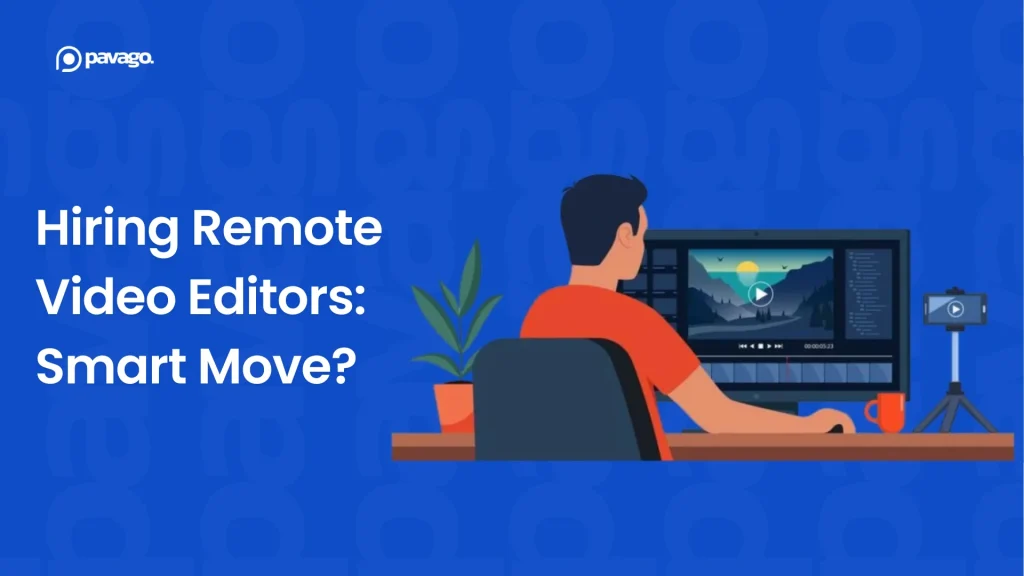You’re ready to scale past $2M. Your team is at 10-15 people. But here’s the problem: hiring the next three or four people locally will blow your budget, and you’re not even sure if the talent is there locally.
You’ve heard about offshore recruitment. You know it can save 40-60% on salaries. But you’re hesitant.
You’ve seen offshore hiring done badly – communication disasters, quality issues, people who disappear after three months…
The question isn’t whether offshore recruitment works. It does. The question is: what are the offshore recruitment strategies that actually work?
This guide breaks down exactly how to build an offshore team that integrates smoothly and sticks around. Not the theoretical version, the real version – what’s worked for Pavago’s founder (plus many others) at your stage.

Why Offshore Makes Sense (And Why It Doesn’t, Sometimes)
Offshore recruitment looks simple: hire cheaper talent globally, save money, done.
Reality is messier because you have multiple offshore challenges to deal with.
Where offshore fails:
You hire someone cheap. They’re technically competent but can’t communicate clearly. They disappear during your timezone. They don’t understand your business context. You spend more time managing the relationship than the work.
Six months later, you’ve hired and fired three people. You’ve spent $30K and shipped nothing. You conclude offshore doesn’t work.
Where offshore wins:
You hire with intention. You vet for communication, independence, and cultural fit – not just technical skills. You set up systems that work async. You integrate them into your team. They become one of your best hires.
The difference? Process.
At $2M revenue with 10+ people, you can’t afford to throw money at mediocre hires anymore. You need every person pulling.
Offshore done right means you get A-players globally at 40-60% lower cost.
Offshore done wrong means you waste time and money.
Related: Why A U.S. Company Should Consider Hiring Offshore Talent
Offshore Recruitment Strategies for Success in 2025
Here’s how to make sure you nail offshore hiring:
Strategy #1: Hire for Remote Fundamentals, Not Just Skills
This is where everything either works or falls apart.
You can find talented developers globally. That’s easy. What’s hard is finding talented developers who can work independently in a distributed team.
Technical skill is table stakes. What predicts offshore success is something else entirely.
What to look for:
- Async communication ability – Can they write clearly without needing calls? Do they ask clarifying questions upfront? Can they explain problems in writing? If they can’t communicate in text, offshore won’t work.
- Self-direction – Do they break down big tasks independently? Do they escalate problems instead of waiting? Do they own solutions end-to-end? Passive people crater in remote environments.
- Cultural alignment – Do they care about what you’re building? Do they want to grow? Can they take feedback? These matter more than perfect credentials.
- Reliability – Will they actually show up? Will they communicate when something’s wrong? Can you build trust with them? This is everything.
How to assess:
Don’t just interview them. Give them a small project. Watch how they communicate. Do they ask questions? Do they explain their approach? Do they follow up proactively?
Ask about their past remote roles. How long did they stay? Why did they leave? What did they learn? People who’ve succeeded in remote work before will succeed again.
Strategy #2: Use an Experienced Offshore Recruitment Partner (Or Know Why You’re Not)
You can hire offshore talent yourself or use a recruitment partner. The right choice depends on your scale and timeline.
What DIY Actually Costs
If you decide to go the DIY route, keep this in mind:
Every hire takes 40-60 hours of screening and interviewing, plus another 20-30 hours for technical assessments, plus 10-15 hours setting up contracts and compliance.
Then there’s the learning curve.
- You’ll figure out which job boards actually work in each country after wasting time and money on ones that don’t.
- You’ll learn to verify credentials after hiring someone whose resume looked real but wasn’t.
- You’ll understand local labor laws after violating them. You’ll learn competitive pay rates after losing good candidates.
- You’ll set up compliant payroll after getting it wrong the first time.
Bad hires cost 3-6 months of salary. Compliance mistakes cost $5K-50K in penalties. Your time costs $14K-20K at $200/hour before anyone even starts.
What Good Partners Handle
Experienced offshore recruitment agencies like Pavago maintain pre-vetted talent pools. You interview 3-5 people instead of 100 because they’ve already filtered for quality.
- They know competitive salaries, benefits expectations, and red flags by region.
- They handle contracts, payroll, taxes, and IP protection through local employment lawyers.
- Most offer 90-day replacement guarantees if someone doesn’t work out. In Pavago’s case, we offer a lifetime replacement guarantee.
- They manage performance issues, compensation questions, and employee relations without pulling you in.
The result? You save hours of work, avoid expensive offshore hiring mistakes, and get offshore hiring right from the get go.
When Each Makes Sense
Use a partner if you’re hiring 1-10 offshore people, lack internal international recruiting expertise, need someone working in 30-45 days, or can’t afford learning through bad hires.
Go DIY if you’re building a 20+ person offshore team, can hire dedicated offshore recruitment staff, have 6-12 months to build systems, and you’re comfortable absorbing mistakes while learning.
Most $2M companies with 10-15 people don’t have the bandwidth to DIY effectively. Partners eliminate 6-12 months of expensive trial and error.
Don’t waste a year learning what we’ve already mastered. Let Pavago handle your offshore recruitment.
Faster hires, fewer mistakes, zero hassle.
Strategy #3: Choose the Right Region for Your Needs
1. Latin America
Best for: Software development, marketing, design, sales, customer success, and nearshore staff augmentation.
Why it works: The timezone difference is only 1–4 hours from the U.S., enabling real-time collaboration. Technical education is strong, and the work culture aligns closely with the US. It’s the ideal region for companies that want nearshore teams deeply integrated with their U.S. operations.
Watch out for: Salary inflation in major tech hubs like Mexico City, Buenos Aires, and São Paulo. Adjust budgets accordingly.
2. Pakistan
Best for: Software development, QA, design, marketing, and data-related work.
Why it works: Pakistan has a large, rapidly expanding tech talent pool with strong English communication and competitive costs. The culture blends well with Western teams, and major cities have deep remote work and startup ecosystems. Many professionals in Pakistan are comfortable working late hours to align with U.S. time zones.
Watch out for: Payroll can be a headache due to changing government policies. It’s better to outsource payroll to a partner like Pavago to simplify compliance and payments.
3. Eastern Europe
Best for: Software development, data science, engineering, and technical writing.
Why it works: Strong engineering education, high professional standards, and EU-level quality. Infrastructure and communication are reliable, making it an attractive offshore recruitment destination.
Watch out for: Limited real-time overlap with the US (6–10 hours ahead of EST). Works best for async-heavy engineering teams.
4. Philippines
Best for: Customer support, virtual assistants, and administrative operations.
Why it works: The Philippines has been a go-to offshore outsourcing destination for several years due to its excellent English proficiency with neutral accents, strong service culture, and dependable talent. Some candidates adjust schedules for partial US overlap.
Watch out for: Night-shift burnout. Prioritize daytime workers who can offer limited U.S.-hour flexibility.
Strategy #4: Set Up Communication Systems Before You Hire
Most companies figure this out after hiring. By then, it’s too late.
You need systems in place that let distributed teams work without constant meetings.
What to establish:
- Primary async channel – Slack for daily updates, questions, and team communication
- Documentation hub – Notion, Confluence for processes, decisions, and context
- Sync windows – specific times for meetings and calls, so people can plan around it
- Written updates – daily or weekly async status updates instead of constant meetings
- Clear approval workflows – so decisions and work get reviewed and approved without delays
The key: document everything that doesn’t require real-time discussion.
A decision gets made? Write it down with context. Has a technical approach been agreed on? Document it. A problem gets solved? Record why that solution was chosen.
This sounds like extra work upfront. It saves 10x that time downstream. New person joins? They read the documentation instead of pestering you with questions.

Strategy #5: Design a Proper Onboarding Process
Most companies onboard offshore hires the same way they onboard local hires. That’s a mistake.
Remote onboarding needs to be more structured, more documented, more intentional.
What to do:
Week 1: Context and foundations
- Clear documentation of your codebase, architecture, and tech stack
- Recorded walkthroughs (Loom videos) of key systems
- Introduction to team members (async, recorded if possible)
- First task: small, isolated, something they can complete independently
Week 2: Real work with support
- Assign a real feature or project, but with mentorship
- Daily overlap time for questions (30-60 minutes)
- Code reviews with detailed feedback
- Check in on how they’re feeling and what they need
Week 3-4: More independence, still support
- Real features now, with less hand-holding
- Still daily standups
- Regular check-ins about integration and blockers
- Start including them in team meetings and decisions
Week 5-6: Integration
- Full features and responsibility
- Treated like any other team member
- Included in strategy and planning
- Celebrated publicly when they ship
Week 7+: Full speed
- They’re shipping at a pace
- Minimal direction needed
- Contributing ideas and improvements
- Integrated into team culture
The difference between companies with 15% offshore turnover and 50% turnover is this process. One does it. The other doesn’t.
Strategy #6: Build Culture Intentionally
Offshore teams fail because they feel like outsiders.
You give them work. They do the work. But they’re not really part of the team.
Six months later, they leave.
What to do:
- Include them in company decisions. Not just “here’s what we decided.” Actually, ask their input. They often have perspectives you miss.
- Celebrate their wins publicly. When they ship something good, tell the team. Not in a patronizing way, though. Give them real recognition.
- Invest in relationships. Monthly virtual coffee. Quarterly async team-building (games, discussions, anything). Annual in-person if possible.
- Respect their time. Don’t assume they’re available whenever. Respect their boundaries, and wait for a response if you message them outside their working hours.
- Offer growth. Not just tasks – we mean career development and learning opportunities. The chance to grow within your company.
The companies that nail this have offshore teams that stay for years. The companies that treat offshore hires like temporary workers have constant turnover.

Strategy #7: Manage Performance Clearly
With distributed teams, you can’t assess performance by “looking busy.” You need actual metrics and regular feedback.
What to track:
- Are they hitting deadlines?
- Is the work quality what you expect?
- Are they communicating proactively?
- Are they learning and improving?
- Are they integrated with the team?
How to manage it:
- Weekly check-ins (15-20 min) focused on blockers and support, not surveillance.
- Bi-weekly or monthly reviews where you give feedback on what’s working and what needs improvement.
- Quarterly, longer conversations about their growth and your expectations.
Critical: Focus on outcomes, not hours. They should be available for communication during working hours, but it shouldn’t make a difference if they worked 4 hours on a particular day, because on some days, they’re going to work 10 hours too.
Strategy #6: Handle Compliance and Legal Right
Different countries have different labor laws, tax requirements, and IP protection rules. Getting this wrong is expensive.
What to handle:
- Clear contracts outlining expectations, payment, IP rights, and termination
- Understanding local labor laws (working hours, benefits, termination procedures)
- Tax implications for both you and them
- Data security and IP protection
- Whether they’re employee, contractors, or something else
Don’t DIY this if you can avoid it. Consult with someone who knows offshore hiring — a lawyer, an HR firm, or an offshore recruitment partner like Pavago.
$1-2K spent upfront on compliance saves $50K in legal problems later.

Wrapping It Up
Offshore recruitment isn’t about finding cheap labor. It’s about building a system that gives you access to top global talent at a fraction of local cost – without sacrificing quality or control.
When done right, offshore recruitment lets you scale faster, extend your team’s capabilities, and compete with companies twice your size. When done wrong, it drains time, money, and energy. The difference is process and execution.
Hire for communication, self-direction, and reliability – not just technical skill. Put systems in place for async collaboration, structured onboarding, and clear performance management. Get compliance right from day one.
At the $2M stage, you can’t afford trial and error. You need offshore hires that integrate quickly, deliver consistently, and stay long term.
That’s where Pavago comes in. We’ve built and managed offshore teams across Latin America, Pakistan, Eastern Europe, and South Africa. Pavago handles everything – sourcing, vetting, payroll, compliance, and onboarding – so you can focus on growth instead of logistics.
You get pre-vetted A-player talent, ready to work in 30 days, backed by our lifetime replacement guarantee.
If you’re ready to scale without the chaos, talk to Pavago.
Faster hires. Fewer mistakes. Zero hassle.
















